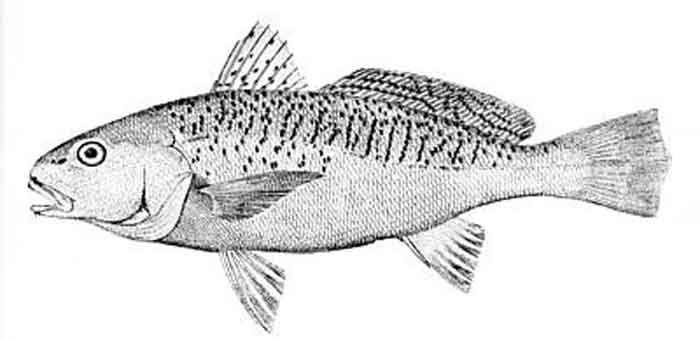Superregnum: Eukaryota
Cladus: Unikonta
Cladus: Opisthokonta
Cladus: Holozoa
Regnum: Animalia
Subregnum: Eumetazoa
Cladus: Bilateria
Cladus: Nephrozoa
Superphylum: Deuterostomia
Phylum: Chordata
Subphylum: Vertebrata
Infraphylum: Gnathostomata
Megaclassis: Osteichthyes
Superclassis/Classis: Actinopterygii
Classis/Subclassis: Actinopteri
Subclassis/Infraclassis: Neopterygii
Infraclassis: Teleostei
Megacohors: Osteoglossocephalai
Supercohors: Clupeocephala
Cohors: Euteleosteomorpha
Subcohors: Neoteleostei
Infracohors: Eurypterygia
Sectio: Ctenosquamata
Subsectio: Acanthomorphata
Divisio/Superordo: Acanthopterygii
Subdivisio: Percomorphaceae
Series: Eupercaria
Ordo: Perciformes
Subordo: Percoidei
Superfamilia: Percoidea
Familia: Sciaenidae
Genus: Micropogonias
Species: M. altipinnis – M. ectenes – M. fasciatus – M. furnieri – M. megalops – M. opercularis – M. undulatus
Name
Micropogonias Bonaparte, 1831
References
Micropogonias – Taxon details on Integrated Taxonomic Information System (ITIS).
Micropogonias species list in FishBase,
Froese, R. & Pauly, D. (eds.) 2024. FishBase. World Wide Web electronic publication, www.fishbase.org, version 02/2024.
Vernacular names
English: Finebarbel croakers

Micropogonias undulatus
Micropogonias is a genus of marine ray-finned fishes belonging to the family Sciaenidae, the drums and croakers. These fishes are found in the eastern Pacific and western Atlantic Oceans.
Taxonomy
Micropogonias was first proposed as a genus in 1831 by the French naturalist and ornithologist Charles Lucien Bonaparte, with Micropogon lineatus being its type species by virtue of being a replacement name.[1] Micropgon lineatus had been described by Georges Cuvier in 1830 with its type locality given as Havana. However, Cuviers' name was objectively invalid as it had already been used for Micropogon Boie, 1826 in birds.[1] It was subsequently determined that Cuviers' M. lineatus was a synonym of Desmarest's Umbrina furnieri and so M. funieri is the type species of the genus Micropogonias.[2] This genus has been placed in the subfamily Micropogoniinae by some workers,[3] but the 5th edition of Fishes of the World does not recognise subfamilies within the Sciaenidae, which it places in the order Acanthuriformes.[4]
Etymology
Micropogonias combines micro, which means "small", with pogonias meaning "bearded", an allusion to the small barbels on the chin of the type species.[5]
Species
Micropogonias has the following species classified within it:[6]
Micropogonias altipinnis Günther, 1865 (Tailfin croaker)
Micropogonias ectenes. (Jordan & Gilbert, 1883) (Slender croaker)
Micropogonias fasciatus (de Buen, 1961)
Micropogonias furnieri (Desmarest, 1823) (Whitemouth croaker)
Micropogonias megalops (Gilbert, 1890)
Micropogonias undulatus (Linnaeus, 1766) (Atlantic croaker)
However, Catalog of Fishes recognises the following species as valid within Micropogonias:[7]
Micropogonias altipinnis (Günther, 1864)
Micropogonias cevegei (Cervigón 1982)
Micropogonias furnieri (Desmarest 1823)
Micropogonias megalops (Gilbert 1890)
Micropogonias undulatus (Linnaeus 1766)
Catalog of Fishes treats M. ectenes as a synonym of M. altipinnis and M. fasciatus as a synonym of Paralonchurus peruanus.[7]
Characteristics
Micropogonias croakers have an elongated body, with a high dorsal profile and an almost flat ventral surface and a conical head. The preoperculum has between 10 and 14 spines on its margin with between 2 and 5 robust spines at its angle. The mouth is under the snout and has villiform teeth arranged in bands, with the outer row in the upper jaw being made up of slightly larger teeth than the rest.[2] The anterior, spiny part of the dorsal fin is quite tall, with the third spine being longer than the others, while the soft rayed part of the dorsal fin is supported by between 26 and 30 soft rays. The anal fin has two spines, the second spine being robust and half the length of first anal fin ray, and between 7 and 9 soft rays. The caudal fin has sharp point.[8] The largest species is the tailfin croaker (M. altipinnis) which has a maximum published total length of 90 cm (35 in) while the smallest, M. megalops, has a maximum published total length of 40 cm (16 in).[6]
Distribution and habitat
Micropogonias croakers are found in the eastern Pacific Ocean and the Western Atlantic Ocean, with two species (M. furnieri and M. undulatus) in the Atlantic (M. cevegei sensu Catalog of Fishes is also found in the Atlantic) and the remaining four in the eastern Pacific.[6][7] These fishes live in estuaries and in inshore waters with sand or mud substrates.[2]
References
Eschmeyer, William N.; Fricke, Ron & van der Laan, Richard (eds.). "Genera in the family Sciaenidae". Catalog of Fishes. California Academy of Sciences. Retrieved 30 May 2023.
Labbish Ning Chao (1978). "A basis for classifying western Atlantic Sciaenidae (Teleostei: Perciformes)" (PDF). NOAA (National Oceanic and Atmospheric Administration) Technical Report NMFS (National Marine Fisheries Service). Circular No. 415.
Kunio Sasaki (1989). "Phylogeny of the family Sciaenidae, with notes on its Zoogeography (Teleostei, Peciformes)" (PDF). Memoirs of the Faculty of Fishes Hokkaido University. 36 (1–2): 1–137.
J. S. Nelson; T. C. Grande; M. V. H. Wilson (2016). Fishes of the World (5th ed.). Wiley. pp. 497–502. ISBN 978-1-118-34233-6.
Christopher Scharpf & Kenneth J. Lazara, eds. (9 March 2023). "Series Eupercaria (Incertae sedis): Families Callanthidae, Centrogenyidae, Dinopercidae, Emmelichthyidae, Malacanthidae, Monodactylidae, Moronidae, Parascorpididae, Sciaenidae and Sillagidae". The ETYFish Project Fish Name Etymology Database. Christopher Scharpf and Kenneth J. Lazara. Retrieved 30 May 2023.
Froese, Rainer and Pauly, Daniel, eds. (2023). Species of Micropogonias in FishBase. February 2023 version.
Eschmeyer, William N.; Fricke, Ron & van der Laan, Richard (eds.). "Species in the genus Micropogonias". Catalog of Fishes. California Academy of Sciences. Retrieved 30 May 2023.
"Genus: Micropogonias, Finebarbel Croaker, Croakers". Shorefishes of the Greater Caribbean online information system. Smithsonian Tropical Research Institute. Retrieved 30 May 2023.
"Micropogonias". Integrated Taxonomic Information System. Retrieved 25 Mar 2007.
Retrieved from "http://en.wikipedia.org/"
All text is available under the terms of the GNU Free Documentation License

